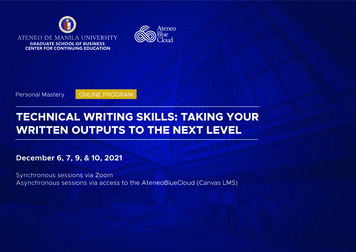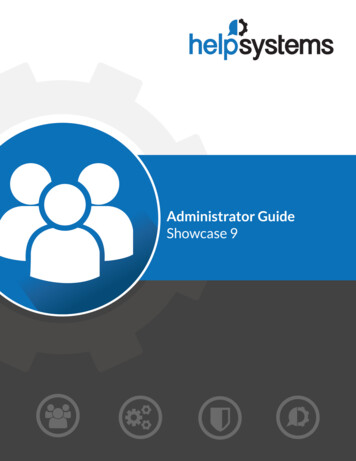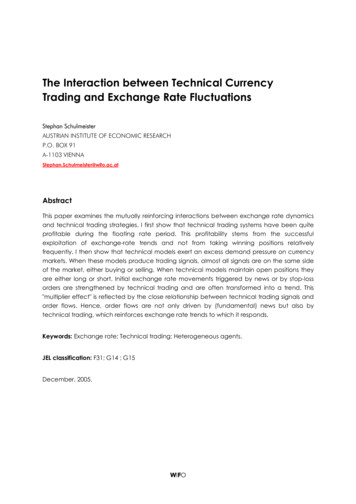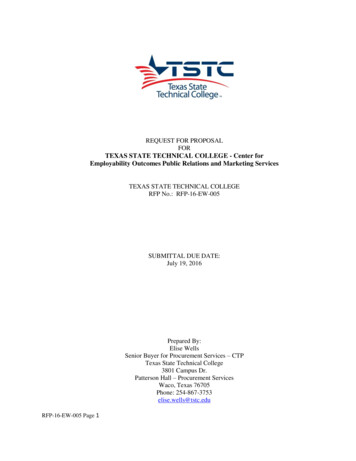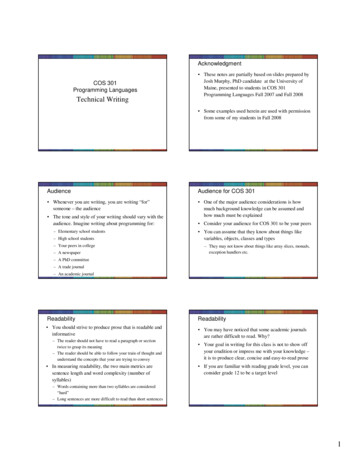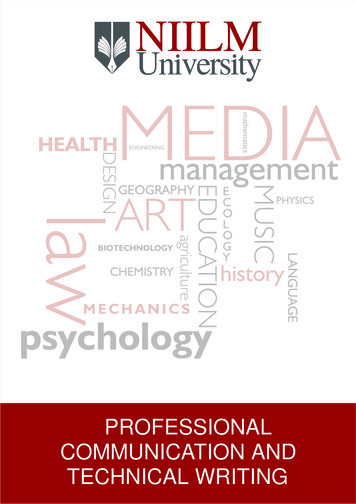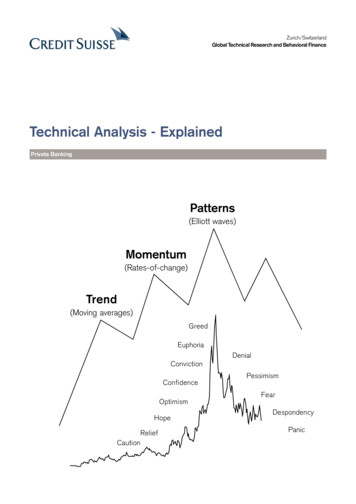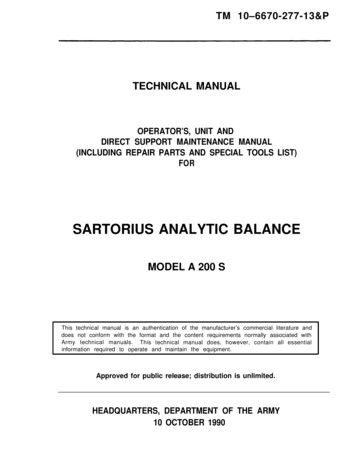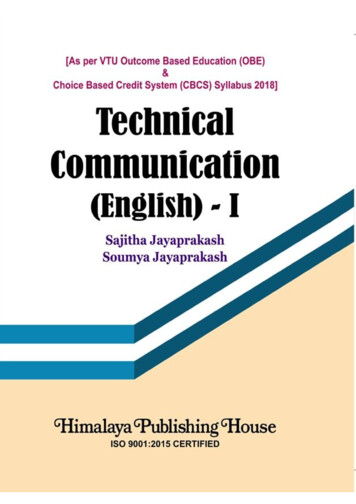
Transcription
TechnicalCommunication(English) – I[As per VTU Outcome Based Education (OBE)&Choice Based Credit System (CBCS) Syllabus 2018]Sajitha JayaprakashSoumya JayaprakashSenior Manager, ProductDocumentation,Training, and e-Learning.Business TechnologyAnalyst.ISO 9001:2015 CERTIFIED
AuthorsNo part of this publication may be reproduced, stored in a retrieval system, or transmitted in any form or by anymeans, electronic, mechanical, photocopying, recording and/or otherwise without the prior written permission of theauthors and the publisher.First Edition : 2018Published by:Mrs. Meena Pandey for Himalaya Publishing House Pvt. Ltd.,“Ramdoot”, Dr. Bhalerao Marg, Girgaon, Mumbai - 400 004.Phone: 022-23860170, 23863863; Fax: 022-23877178E-mail: himpub@vsnl.com; Website: www.himpub.comBranch Offices:New Delhi:“Pooja Apartments”, 4-B, Murari Lal Street, Ansari Road, Darya Ganj, New Delhi - 110 002.Phone: 011-23270392, 23278631; Fax: 011-23256286Nagpur:Kundanlal Chandak Industrial Estate, Ghat Road, Nagpur - 440 018.Phone: 0712-2721215, 3296733; Telefax: 0712-2721216Bengaluru:Plot No. 91-33, 2nd Main Road, Seshadripuram, Behind Nataraja Theatre,Bengaluru - 560 020. Phone: 080-41138821; Mobile: 09379847017, 09379847005Hyderabad:No. 3-4-184, Lingampally, Besides Raghavendra Swamy Matham, Kachiguda,Hyderabad - 500 027. Phone: 040-27560041, 27550139Chennai:New No. 48/2, Old No. 28/2, Ground Floor, Sarangapani Street, T. Nagar,Chennai - 600 012. Mobile: 09380460419Pune:“Laksha” Apartment, First Floor, No. 527, Mehunpura,Shaniwarpeth (Near Prabhat Theatre), Pune - 411 030.Phone: 020-24496323, 24496333; Mobile: 09370579333Lucknow:House No. 731, Shekhupura Colony, Near B.D. Convent School, Aliganj,Lucknow - 226 022. Phone: 0522-4012353; Mobile: 09307501549Ahmedabad:114, “SHAIL”, 1st Floor, Opp. Madhu Sudan House, C.G. Road, Navrang Pura,Ahmedabad - 380 009. Phone: 079-26560126; Mobile: 09377088847Ernakulam:39/176 (New No. 60/251), 1st Floor, Karikkamuri Road, Ernakulam,Kochi - 682 011. Phone: 0484-2378012, 2378016; Mobile: 09387122121Bhubaneswar:Plot No. 214/1342, Budheswari Colony, Behind Durga Mandap,Bhubaneswar - 751 006. Phone: 0674-2575129; Mobile: 09338746007:108/4, Beliaghata Main Road, Near ID Hospital, Opp. SBI Bank,Kolkata - 700 010. Phone: 033-32449649; Mobile: 07439040301DTP by:Hansa BhoirPrinted at:M/s. Aditya Offset Process (I) Pvt. Ltd., Hyderabad. On behalf of HPH.Kolkata
PREFACECommunication skills is a requirement for everyone. You need it in your personal life,school/college life, and professional life. No matter what profession you are in, communicationskills give an extra edge. Communication skills can be improved by understanding the basictheoretical concepts, implementing them, and practicing them.To be accepted in today’s competitive world, you need to be able to write well and speakwell. You have to speak and write correct English, with clarity in expression. Unfortunately,communication is a practical subject. It is important to understand the concepts and theory. Moreimportantly, able to practice it well.In the last couple of years, there has been a sudden increase in the need for technicalcommunicators (technical writers) in India. Many multinational companies having theirdevelopment centers in India are setting up their documentation teams here. Though manyorganizations are ready to hire freshers and provide them with in-house training, it is oftendifficult to find someone who fits in to the profile well. This is due to lack of combination of thetechnical background and writing skills.Contents of this BookThe contents of the book are as follows:Chapter 1: Introduction to CommunicationThis chapter discusses the following topics: Communication: Information regarding the importance, the principles, the types andadvantages of communication. It describes briefly the barriers to effective communicationand also provides pointers to overcome those barriers. Interpersonal skills: Introduces interpersonal skills and tells you how to improve yourinterpersonal skills. Technical communication: Introduces one to technical communication and brieflyexplains the skills required for technical communication.Chapter 2: PhoneticsThis chapter contains the following topics: Phonetics: Information regarding types of phonetics and International PhoneticAlphabet (IPA). Sounds: It is about speech sounds, vowels, and consonants. Pronunciation: Sounds mispronounced, silent letters, pronunciation of the word the,and words ending with –age and –able.Chapter 3: Developing Phonetics and VocabularyThis chapter contains the following topics: Accent: Types and causes of word accent, rules for word accent, stress patterns, stressshift, importance of word stress, and word stress rules. Question Tag: Question tag for assertive statements and negative statements.
One word substitute Interrelationships of Words: Synonyms, antonyms, homophones, homonyms, homograph,heterography, polyseme, and capitonym.Chapter 4: Speaking SkillsThis chapter contains the following topics: Syllable: Importance of syllables, ways to count them, and division rules. It alsocontains information regarding spoken and written syllables, and types of syllables. Words: Word formation, types of word formations, word structure, strong and weakforms of words, word pairs, and words often misspelt. Prefix and suffix: Categories of suffix. Spelling Rules: Learn the various spelling rules.Chapter 5: Public SpeakingThis chapter contains the following topics: Public Speaking: Public speaking process, types of public speech, Lasswell’scommunication model, importance of public speaking, mastering public speaking Extempore Speaking: Guidelines and some topics for practice Difference between extempore and public speaking English in India Techniques for Neutralization of MTI (Mother Tongue Influence) Listening Comprehension Information Transfer Oral Presentation: Preparing a presentation and structuring the oral presentationChapter 6: GrammarThis chapter contains the following topics: Nouns: Types and examples of nouns Pronouns Adjectives Verbs Prepositions Articles Conjunctions ArticlesThough we have tried to ensure that the information presented here will enable students toachieve higher levels of learning, we would be extremely happy to receive any constructivecomments and suggestions for improvement (from both, the students and teachers/lecturers).Authors
SYLLABUSObjective: The course (18EGHL18) will enable the students to: Acquire basic English grammar and essentials of language skills Clarify the nuances of phonetics, intonation and pronunciation skills Get familiarized with English vocabulary and language proficiencyModule – I: Introduction to Technical CommunicationFundamentals of Technical Communication Skills, Barriers to Effective Communication,Different Styles in Technical Communication. Interpersonal Communication Skills, How toImprove Interpersonal Communication Skills, Developing Interpersonal Skills. Grammar: BasicEnglish Grammar and Parts of Speech – Nouns, Pronouns, Adjectives, Verbs, Adverbs,Preposition, Articles, Conjunctions.Module – II: Introduction to Listening Skills and Phonetics – IIntroduction to Phonetics, Sounds Mispronounced, Silent and Non-silent Letters,Homophones and Homonyms, Aspiration, Pronunciation of ‘The’, Words Ending with ‘-age’,Some Plural Forms. Use of Articles – Indefinite and Definite Articles.Module – III: Developing Listening Skills (Phonetics and Vocabulary Building) – IISpeech Sounds: Vowels and Consonants – Exercises on it. Preposition, Kinds of Prepositionand Prepositions Often Confused. Word Accent – Rules for Word Accent, Stress Shift, QuestionTags, Question Tags for Assertive Sentences (Statements) – Some Exceptions in Question Tagsand Exercises, One Word Substitutes and Exercises. Vocabulary – Synonyms and Antonyms,Exercises on it.Module – IV: Speaking Skills (Grammar and Vocabulary) – ISyllables, Structures, Strong and Weak Forms of Words, Words Formation – Prefixes andSuffixes (Vocabulary), Contractions and Abbreviations. Spelling Rules and Words OftenMisspelt – Exercises on it. Word Pairs (Minimal Pairs) – Exercises, The Sequence of Tenses(Rules in Use of Tenses) and Exercises on it.Module – V: Speaking Skills (Grammar and Vocabulary) – IIExtempore/Public Speaking, Difference between Extempore/Public Speaking, andGuidelines for Practice. Mother Tongue Influence (MTI) – South Indian Speakers, VariousTechniques for Neutralisation of MTI Influence – Exercises, Listening Comprehension –Exercises. Information Transfer: Oral Presentiment – Examples. Common Errors in Pronunciation.
CONTENTS1.Introduction to Communication1 – 302.Phonetics31 – 523.Developing Phonetics and Vocabulary53 – 784.Speaking Skills79 – 1155.Public Speaking116 – 1566.Grammar157 – 220
Introduction toCommunication1Chapter Contents1.1 What is Communication?1.2 Why is Communication Important?1.3 Principles of Communication1.4 Advantages of Effective Communication1.5 Types of Communication1.5.1Verbal Communication1.5.2Written Communication1.5.3Non-verbal1.6 Barriers to Effective Communication1.6. 1Language Barriers1.6. 2Psychological Barriers1.6. 3Physical Barriers1.6. 4Physiological Barriers1.6. 5Gender Barriers1.6. 6Attitudinal Barriers1.6. 7Perceptual Barrier1.6. 8Cultural Differences1.6. 9Information Overload1.6. 101.7InattentionOvercoming Barriers of Communication1.8 Interpersonal Communication Skills
Technical Communication (English) – I21.9 Improving Interpersonal Communication Skills1.9.1Clarity1.9.2Listen Actively1.9.3Maintain Eye Contact1.9.4Non-verbal Communication1.9.5Do Not Interrupt1.9.6Respect Others’ Thoughts and Opinions1.9.7Think Before You Speak1.9.8Focus on the Message1.9.9Don’t Get Defensive1.9.10Don’t Deviate1.9.11Questioning1.9.12Manners1.10 Technical Communication1.11 Technical Communication Skills1.11.1Language Skills1.11.2Writing Skills1.11.3Ability to Understand the Subject1.11.4Interpersonal Skills1.11.5Ability to Analyze1.11.6Flexibility
Introduction to Communication31.1 What is Communication?According to Merriam Webster, communication is a process by which there is a meaningful exchangeof information through exchange of thoughts, messages, speech, visuals, signals, or writing, betweentwo or more living beings. This exchange can be through a common system of speech, symbols, signs,or behaviour!We cannot dispute the fact that we need to communicate. We need to communicate efficiently andeffectively to function as civilized human beings.“Communication is a process of sharing information with another person in such a way that he or sheunderstands what you are saying.”– Dr. H. Norman WritingCommunication is a tool with which we exercise our influence on others, bring out changes in our andothers’ attitudes, motivate the people around us and establish and maintain relationships with them.Communication makes a major part of our active life and is a social activity. This social activity ispursued verbally through speech, reading and writing or non-verbally through body language.The main components of communication process are as eEffectFeedback1.2.3.Context: Every message, irrespective of the type, begins with a context. Communication isaffected by the context in which it takes place. This context may be physical, social,chronological or cultural. Every communication proceeds with context. The sender chooses themessage to communicate within a context. Context is a very broad field that consistsdifferent aspects.One aspect is country, culture and organization. Every organization, culture and countrycommunicates information in their own way.External stimulus: The sources of external stimulus includes; meeting, letter, memo,telephone call, fax, note, email and even a casual conversation. This external stimulimotivates you to respond and this response may be oral or written.Internal stimuli: It includes your opinion, attitude, likes, dislikes, emotions, experience,education and confidence. All these have multifaceted influence on the way youcommunicate your ideas.As a sender you can communicate the ideas effectively by considering all aspects of contextmentioned above.
Technical Communication (English) – I44.5.Sender: Sender (or encoder) is a person who sends the message. A sender makes use of acombination of symbols, words, graphs and pictures understandable by the receiver, to bestconvey the message in order to achieve the desired response. The views, background,approach, skills, competencies, and knowledge of the sender have a great impact onthe message. The verbal and non verbal symbols chosen are essential in ascertaininginterpretation of the message by the recipient in the same terms as intended by thesender.Message: Message is the information that is exchanged between the sender and the receiver.The first task is to decide the following: What you want to communicate What would be the content of your message What are the main points of your message6. What other information to include.The central idea of the message must be clear. While writing the message, the sender shouldkeep in mind all the aspects of context and the receiver. The sender must ensure that themain objective of the message is clear. Messages can be intentional and unintentional, by thesender.Medium: It is the channel through which the message is exchanged and/or transmittedbetween the sender and the receiver. The choice of appropriate medium of communication isessential for making the message effective and correctly interpreted by the recipient. Hence,the sender must choose an appropriate medium for transmitting the message. Else, themessage might not be conveyed to the recipients.The choice of communication medium varies depending upon the features ofcommunication: It depends on the nature and type of your message.7. It is also influenced by the relationship between the sender and the receiver.The oral medium, is effective when your message is urgent, personal or when immediatefeedback is desired. Written medium is preferred, when your message is technical and needsto be documented.Recipient: Recipient (or decoder) is a person to whom the message is sent. The degree towhich the decoder understands the message is dependent upon various factors such as: The reliance of encoder on decoder8. Knowledge of recipient Responsiveness of recipient to the messageFeedback: Feedback is the main component of the communication process as it permits thesender to analyze the efficacy of the message. It helps the sender in confirming the correctinterpretation of message by the decoder. Feedback completes the loop of communication.Feedback may be verbal (through words) or non-verbal (in form of smiles, sighs, etc.). Itmay also be take in written form---memos, reports, feedback forms, etc.
Introduction to Communication51.2 Why is Communication Important?Communication is important in all walks of life because we live and work with people.Communicating the intended message clearly and effectively is an important skill. Improving yourcommunication skills is an art that comes with regular practice. As we all know, practice makes a manperfect. No matter how intelligent you are, good and positive communication is the only skill that willhelp you to succeed in life. It is also the key factor in deciding the chances of success inrelationships—professionally and personally. So, ensure to make wise and polite use of your wordswhen talking to people.In the information age, we send, receive, and process huge numbers of messages every day. It could bevia different medium—face-to-face, email, phone, text message, WhattsApp, Facebook, twitter, etc.Effective communication is about more than just exchanging information. It is also aboutunderstanding the emotion behind the information, the reason for transmitting the information,ensuring that the receiver will not be confused and will receive the correct information.Effective communication can improve personal and professional relationships by:(a) Increasing your capacity to recognize and understand your own emotions and those of theperson you are communicating with.(b) Combining a set of skills including nonverbal communication, attentive listening, and theability to manage stress at the moment of communication.(c) Enabling you to communicate even negative or difficult messages without creating conflictor destroying trust.(d) Deepening your connections with the person or people you are communicating with.(e) Improving interaction, decision-making, and problem solving.Effective communication is really both an art and a science. You as, a sender need to focus on twothings while communicating: Ensure that the intended meaning is totally retained and nothing is lost, so that thecommunicated message is received clearly and precisely by the receiver. Be sensitive in the way you phrase and package the message. This is to ensure that therelationships are kept affable.1.3 Principles of CommunicationLack of effective communication creates misunderstanding and commotion. So, it is important tofollow certain principles to ensure effective communication. They are as follows:(a) Clarity: It means the communicator should use such a language which is easy to understand.The message must be understood by the receiver. The words used should be simple andunambiguous. The language should not create any confusion or misunderstanding. Languageis the medium of communication; hence it should be clear and understandable.(b) Adequacy and Consistency: The communicator must carefully take into account that theinformation to be communicated should be complete and adequate in all respect. Inadequateand incomplete message creates confusion and delays the action to be taken. The adequateinformation must be consistent with the organizational objectives, plans, policies and
Technical Communication (English) – I6(c)(d)(e)(f)(g)procedures. The message which is inconsistent may play havoc and distort the corporateinterests.Integration: It states that the efforts taken by the educational institutions, or organisationshould be integrated towards achievement of the objectives through communication. Thevery aim of communication is to achieve the set target. The communication should aim atcoordinating the activities of the people to attain the common goals.Economy: In a corporate set up, unnecessary use of communication system can add to thecost. You must use the system of communication efficiently, in a timely manner and when itis necessary.Feedback: The purpose of communication will be defeated if feedback is not taken from thereceiver. The confirmation of the receipt of the message in its right perspective from itsreceiver fulfills the object of communication. The feedback is essential only in case ofwritten communication and messages sent through messengers. In case of oral type ofcommunication, we receive the feedback immediately.Need for Communication Network: The route through which the communication passesfrom sender or communicator to its receiver or communicate refers to communicationnetwork. For effective communication this network is essential. The managerialeffectiveness will also depend upon the availability of adequate network.Attention: The message communicated must draw the attention of the receiver and ensureaction from that person in the right perspective. For example, an efficient, sincere andprompt manager will succeed in drawing the attention of his subordinates to what he isconveying.It is the psychology of the human nature that they watch their seniors or superiors closely and respondto their orders or instructions. Adhering to the above principles shall make communication effective,minimize the human-relations problems and increase the overall efficiency.1.4 Advantages of Effective CommunicationIn the era of globalisation, we cannot ignore the strategic importance of communication. By learningthese effective communication skills, you can connect with your friends, parents, colleagues, spouse,and/or co-workers better. We have to take a stock of ineffective and effective communicationcharacteristics.Effective communication skills does the following:1. Build lasting relationships: Everyone knows at least one person who has had some of thesame friends for decades. Research shows that it’s not only what a person says that keepsthese relationships intact, but the way you say it.Research states that the way you communicate something determines lifelong relationships.According to the research, non-verbal cues such as tone, pitch and intensity duringarguments makes or breaks a relationship. They concluded that the couples that hadcontrolled vocal acoustics were more likely to stay together. Any relationship—whethermarriage or friendship—will fare better if you speak in kinder and more understanding ways.2. Be approachable: Effective communication is a vital tool in building and maintaining yourrelationship. It makes others feel comfortable with approaching you any time they need orwant to talk about anything that might be bothering them. When you are approachable,
Introduction to Communication3.4.7people respect and understand you. People are likely to have a more open and healthyrelationship if they are approachable. Many married couples live together but they cannotapproach each other because the relationship lacks the comfort level that allows for certainsubjects to be discussed.Breeds trust: Effective communication helps in building trust and respect. When you trustsomeone, you are able to rely on them and confide in them. When meeting in person, it iseasier to pick out the body language and other visual cues of communication. It helps peopleto better understand each other and the message that is being conveyed.A study asked students to collaborate on a project. One group communicated only in person.The other only through technological means with less-visual cues. The group that metface-to-face, showed the most trust and effective cooperation.Creates positivity: Open communication creates positive environments where creativeideas, problem solving, affection, and caring can flourish. It helps you better understand aperson or situation thus enabling you to resolve differences. It also enhance your ability tomake a positive and lasting impression on peers, superiors, and on all those with whom youcome into contact. Positive interactions with others ultimately feel supportive and effective.1.5 Types of CommunicationIn a general context, all communication can be divided into two broad categories: formal and informal.Each of these can be further dived into three forms of communication:1. Written: in which you read their meaning2. Verbal3. uageSounds Volume & extInflectionInterpretationSignals Facial ationEye ContactGesturesBody LanguageSign LanguageSignalsWritten
8Technical Communication (English) – I1.5.1 Verbal CommunicationIn this type of communication, you listen to a person to understand what they are saying andcomprehend the meaning. It implies communication through mouth. It includes individuals conversingwith each other, be it direct conversation or telephonic conversation. Speeches, presentations,discussions are all forms of oral communication. Verbal communication takes place in real time.Verbal/oral communication is recommended when a direct interaction is required. Face-to-facecommunication (meetings, lectures, conferences, interviews, etc.) is significant to build a rapport and trust.Advantages of Verbal Communication There is high level of understanding and transparency in oral communication as it isinterpersonal. There is no element of rigidity in oral communication. There is flexibility for allowingchanges in the decisions previously taken. The feedback is spontaneous in case of oral communication. Thus, decisions can be madequickly without any delay. It is not only time saving, but it also saves upon money and efforts. It is best in case of problem resolution. The conflicts, disputes and many issues/differencescan be put to an end by talking them over. Oral communication is an essential for teamwork and group energy. It promotes a receptive and encouraging morale among organizational employees. It can be best used to transfer private and confidential information/matter.Limitations of Verbal Communication Relying only on verbal communication may not be sufficient as business communication isformal and very organized. It is less authentic than written communication as they are informal and not as organized aswritten communication. Though it is time-saving in daily interactions, but in case of meetings, long speechesconsume lot of time and are unproductive at times. They are not easy to maintain and thus they are unsteady. There may be misunderstandings as the information is not complete and may lack essentials. It requires attentiveness and great receptivity on part of the receivers/audience. Verbal communication (such as speeches) is not frequently used as legal records except ininvestigation work.
Introduction to Communication91.5.2 Written CommunicationIn contrast to verbal communications, written business communications are printed messages. It hasgreat significance in today’s business world. It is an innovative activity of the mind. Writtencommunication is the most important and the most effective of any mode of business communication.Written communication does not happen in real time. It can be constructed over a longer period oftime. Written communication is often asynchronous, that is it occurs at different times. This meansthat, the sender can write a message that the receiver can read at any time, unlike a verbal conversationthat happens at a real time.Written communication is the most important and the most effective of any mode of businesscommunication. Some of the various forms of written communications that are used internally forbusiness operations include: Memos Reports Bulletins Job descriptions Employee manuals E-mails Instant messagesExamples of written communications generally used with clients or other businesses include: E-mail Internet websites Letters Proposals Telegrams Faxes Postcards Contracts Advertisements Brochures News releasesThey may be handwritten, printed on paper, or appear on the screen. A written communication can beone-to-one (read by one person) or one-to-many (read by many people) communication. Conferencecalls and speeches one-to-many communications. E-mails may have only one recipient or many.Disadvantages of Written Communication Written communication costs in terms of stationery and the manpower employed inwriting/typing and delivering letters. If the receivers of the written message are separated by distance and if they need to cleartheir doubts, the response is not spontaneous.
Technical Communication (English) – I10 Written communication is time-consuming as the feedback is not immediate. The encodingand sending of message takes time.Effective written communication requires great skills and competencies in language andvocabulary use. Poor writing skills and quality, have a negative impact on the organization’sreputation.1.5.3 Non-verbalNonverbal communication as the name suggested does not have any verbal or spoken words forcommunication. In this type of communication, you observe a person and infer the meaning. Itinvolves the nonverbal stimuli in a communication setting that are generated by the source (speaker).It involves sending and receiving messages through gestures, actions, facial expressions, bodylanguage, clothing, and other aspects of your physical appearance, that, when seen, communicatesomething.What you say is a vital part of any communication. But what you don’t say is even more important.Research also shows that 55% of communication comes from nonverbal cues like facial expressions,body stance, and tone of voice. According to one study, people comprehend only 7% of a messagebased on the sender’s actual words. 38% is based on paralanguage (the tone, pace, and volume ofspeech), and 55% is based on non-verbal cues (body language). So, non-verbal communication is veryimportant.Some factors that help in nonverbal communication are:1. Culture: Different cultures have different gestures, postures and different body movementthat have different meaning attached to it. Even simple things like using hands to point,wave, or count differ. For example, in the US people usually point with the index finger. InJapan and in India, it is considered rude. Instead people point with an entire hand.2. Body language: Believe it or not, postures and body language speaks a lot—it easilyconveys your feelings and attitudes and shows if you are interested or disinterested in whatis being said. For example, a speaker who leans forward appears to be very interested ratherthan the one who slouches.Your bodylanguage saysyou’ve lostinterest3.Facial expressions: It plays a major role in nonverbal communication as people can readyour expression and make out what you are thinking and feeling. A person with goodexpressions can communicate better than the one who is expressionless.
Introduction to Communication4.11DismayedInterestedConfidentPower lessScaredHostileGrief-strickenShockedAppearance: Appearance is a very important factor of nonverbal communication. Youroutfit conveys a clear message about you personality. That’s why we often say that theclothes must be appropriate to the situation and/or location. According to a survey, 76.4%think that hiring decisions are influenced by appearance. Only 3.7% feel that it is not.In business settings women are generally expected to wear minimal make
Technical communication: Introduces one to technical communication and briefly explains the skills required for technical communication. Chapter 2: Phonetics This chapter contains the foll
